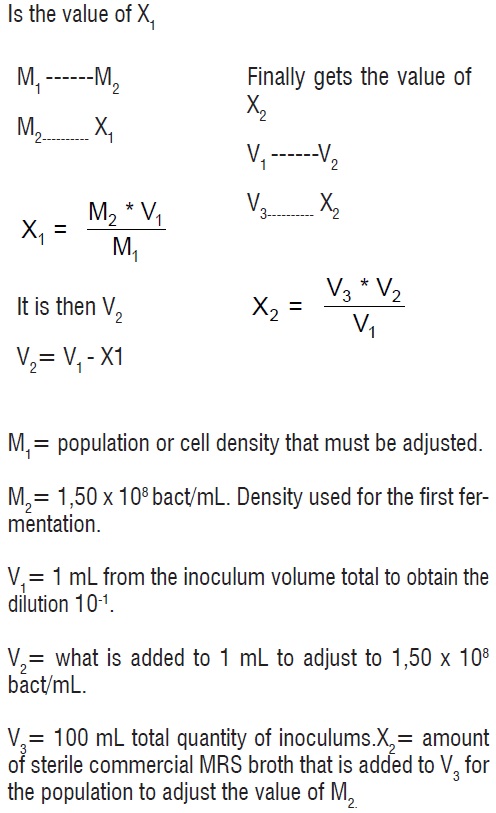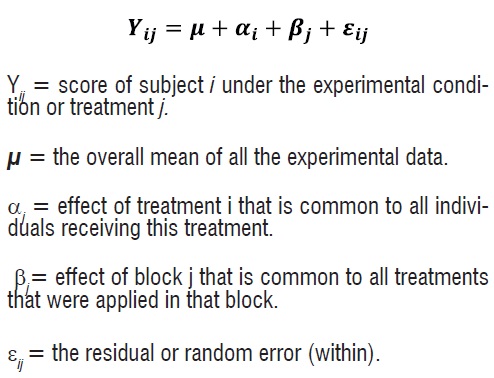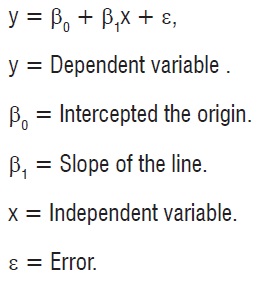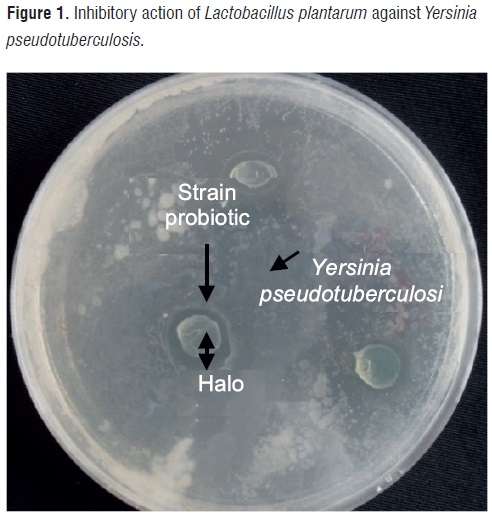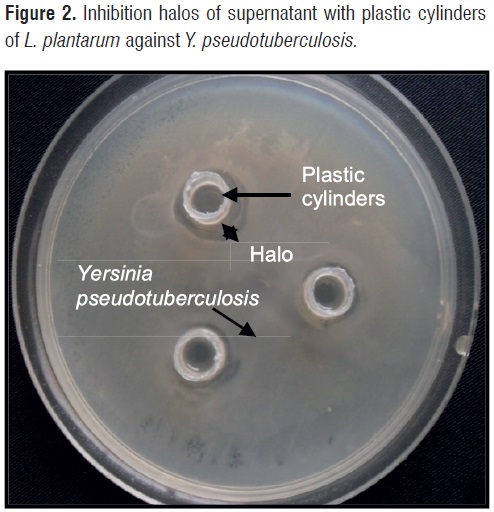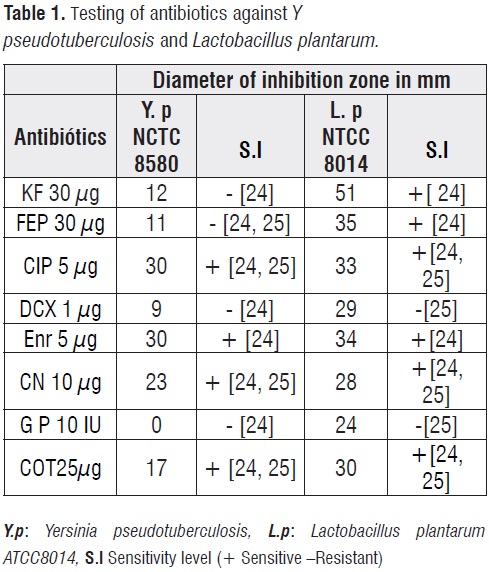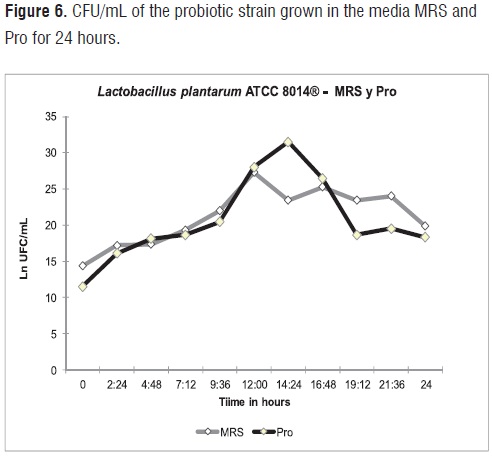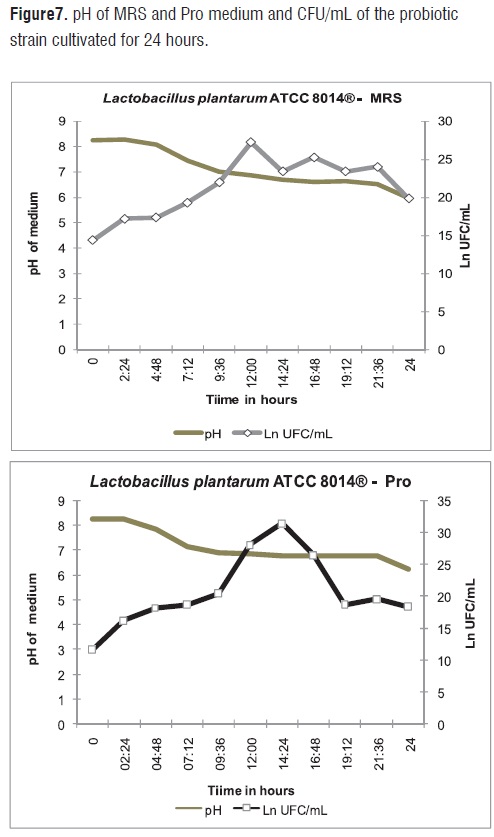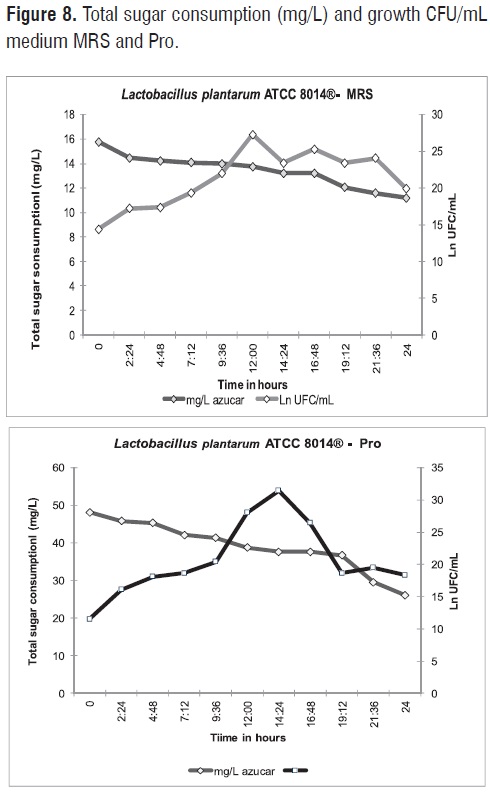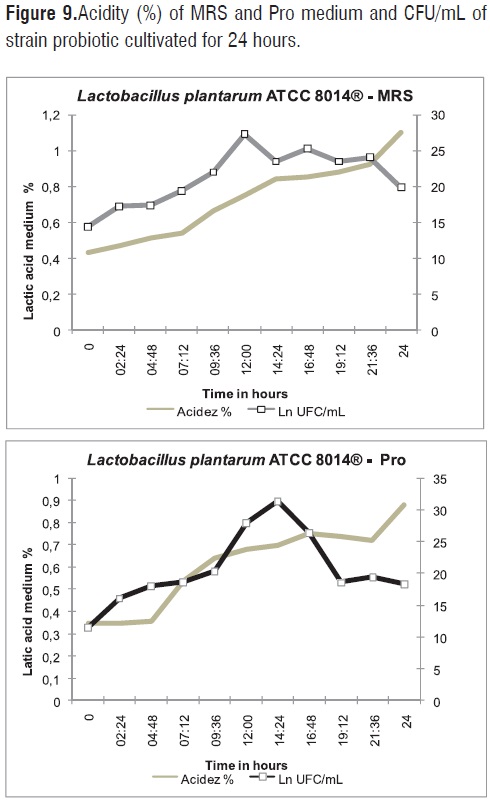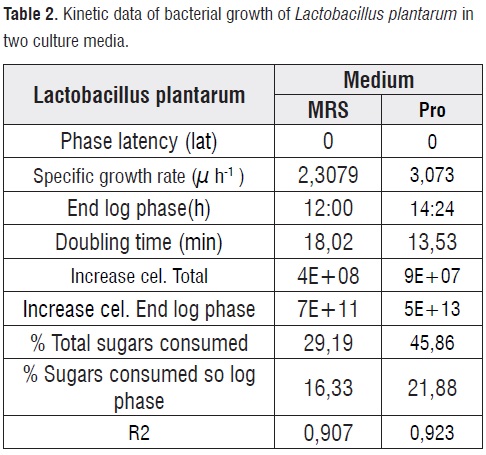Services on Demand
Journal
Article
Indicators
-
 Cited by SciELO
Cited by SciELO -
 Access statistics
Access statistics
Related links
-
 Cited by Google
Cited by Google -
 Similars in
SciELO
Similars in
SciELO -
 Similars in Google
Similars in Google
Share
Biotecnología en el Sector Agropecuario y Agroindustrial
Print version ISSN 1692-3561
Rev.Bio.Agro vol.12 no.2 Popayán July/Dec. 2014
EVALUATION in vitro OF THE ACTION OF Lactobacillus plantarum WITH PROBIOTIC CHARACTERISTICS ON Yersinia pseudotuberculosis
EVALUACIÓN in vitro DE LA ACCIÓN DE Lactobacillus plantarum CON CARACTERÍSTICAS PROBIÓTICAS SOBRE Yersinia pseudotuberculosis
AVALIAÇÃO in vitro DA AÇÃO DE Lactobacillus plantarum COM CARACTERÍSTICAS PROBIÓTICAS SOBYersinia pseudotuberculosis
HENRY JURADO-GÁMEZ1, JAVIER ANDRÉS MARTÍNEZ B.2, AURA MAGDALENA CHASPUENGAL T.3, FREDY YESID CALPA Y.3
1Universidad de Nariño, Facultad de Ciencias Pecuarias, Departamento de Producción y Procesamiento Animal, Programa de Zootecnia. Ph.D en Ingeniería de Alimentos. Pasto, Colombia.
2Universidad de Nariño, Facultad de Ciencias Pecuarias, Departamento de Producción y Procesamiento Animal, Programa de Zootecnia. Magister en Ciencias en Industria Pecuaria. Pasto, Colombia.
3 Grupo de Investigación en Procesos Biotecnológicos Aplicados a la Producción Animal - Fisiología y Etología Animal (PROBIOTEC-FISE).Zootecnista.Pasto, Colombia.
Correspondencia: henryjugam@gmail.com
Recibido para evaluación: 31-01-2014. Aprobado para publicación: 30-05-2014.
RESUMEN
Con el objetivo comprobar el potencial probiótico de Lactobacillusplantarumsobre una de las enfermedades más frecuente en cuyes (Cavia porcellus) causada por Yersiniapseudotuberculosis, se efectuaron pruebas de inhibición y comparación frente a antibióticos, mostrando resultados favorables, al inhibir a la bacteria patógena. Se valoró por HPLC los posibles péptidos producidos por L. plantarum, evidenciándose la presencia de dos péptidos. Se realizaron pruebas de selección de la bacteria láctica la cual mostró el siguiente perfil:catalasa negativa, no productora de gas, resistente a sales biliares (0,5%, 1%, 2% y 3%), pH (2,5, 3,5 y 7,6) y temperatura de 38 a 45°C. Además, se determinó las características de la cinética de fermentación, utilizando dos medios, donde se evaluó UFC/mL, pH, consumo de azúcares totales (mg/L) y producción de ácido láctico (%); Lactobacillusplantarum alcanzó la fase exponencial de crecimiento en los medios MRS y Pro, a las 12 y 14:24 horas, con valores de 7,0x1011UFC/mL y 5,0x1013UFC/mL, respectivamente. Se aplicó un diseño de bloqueas al azar con dos tratamientos y once bloques, el resultado permitió determinar que no existe diferencias estadísticas significativas (P>0,05) entre los medios propuestos, pero si entre las horas de evaluación (P<0,05).
PALABRAS CLAVE: Probióticos, Bacteria patógena, Inhibición, Bacteria láctica, Cinética de fermentación.
ABSTRACT
Withtheobjectivetocheckthepotential probiotic of Lactobacillusplantarumonone of themostfrequentdiseases in guinea pig(Cavia porcellus)causedbyYersiniapseudotuberculosis, testswereconducted of inhibition and comparisonin front of antibiotics, showing favorable results, theinhibittothepathogenicbacterium. Itvaluedby HPLC thepossiblepeptidesproducedbyL. plantarum,characterizinganpresence of twopeptides. Tests were performed for the selection of lactic bacteria which showed the following profile: catalase-negative, not producer of gas, resistant to bile salts (0, 5%, 1%, 2% and 3%), pH (2,5, 3,5 and 7,6) and temperature of 38 at 45°C. Also determined the characteristics of the kinetics of fermentation, using two mediums, where it is evaluated CFU/mL, pH, consumption of total sugars (mg/L) and production of lactic acid (%); Lactobacillus plantarum reached the exponential phase of growth in the mediums MRS and Pro, at the 12 and 14:24 hours, with values of 7,0x1011UFC/mL and 5,0x1013UFC/mL, respectively. A design of blocks was applied at random with two treatments and eleven blocks, the result allowed to determine that it doesn't exist significant statistical differences (P>0,05) between the proposed means, but if between the hours of evaluation (P <0,05).
KEYWORDS:Probiotics, Bacteria pathogen, Inhibition, Lactic bacteria, Kinetics of fermentation.
RESUMO
Com o objetivo comprovar o potential probiótico de Lactobacillus plantarumsobre uma das doenças mais freqüentes em cuyes(Cavia porcellus) causada por Yersinia pseudotuberculosis, efectuaram-se testes de inibição e comparação em frente a antibióticos, mostrando resultados favoráveis, ao inhibir à bactéria patogénica.Valorizou-se por HPLC os possíveis péptidos produzidos por L. plantarum, evidenciándose a presença de duas péptidos.Realizaram-se testes de seleção dabactérias láctica a qual mostrou o seguinte perfil: catalase negativo, não produtor de gás, resistente a sais biliares(0,5%, 1%, 2% e 3%), pH (2,5, 3,5 e 7,6) e temperatura de 38 a 45°C. Além disso, determinaram-se as características da cinética de fermentação, utilizando dois meios, onde se avaliou UFC/mL, pH, consumo de açúcares totais (mg/L) e produção de ácido láctico (%);Lactobacillusplantarumalcançaram a fase exponencial de crescimento nos meios MRS e Pro, às 12:00 e 14:24 horas, com valores de 7,0x1011UFC/mL e 5,0x1013UFC/mL, respectivamente. Aplicou-se um desenho de blocos ao acaso com dois tratamentos e onze blocos, o resultado permitiu determinar que não exista diferenças estatísticas significativas (P>0,05) entre os meios propostos, mas se entre as horas de avaliação (P <0,05).
PALAVRAS-CHAVE: Probióticos, Bacteria patógeno, Inibição, Bactérias lácticas, Cinética de fermentação.
INTRODUCTION
At present, the use of probiotics takes importance to be considered as the cultivation of one or more living micro-organisms, that to be supplied in the diet have an influence on the microflora already established, producing a positive effect very marked on the health and development of the host[1].The benefits of the probióticos are multiple, between them is outlined the production of antibacterial substances that improve the defense against the invasion of other microorganisms; and they help to populate the intestinal flora that can turn altered by the administration of antibiotics [2], being considered therefore with therapeutic effects or preventive in the guest[3].
The use of bacteria of the kind Lactobacillus specially the species L. plantarum, has been used widely in vivo and in vitro, demonstrating his antimicrobial capacity against different bacteria gram positive and gram negative like Listeria monocytogenes, Staphylococcus aureus, Salmonella tiphymurium, Escherichia coli, Klebsiellapneumoniae, between others [4,5,6]; is capable of tolerating low pH and bile salts, has antagonistic activity against pathogenic intestinal such as the enterobacterias [7], and corresponds to the microorganisms GRAS, that is to say Generally Recognized As Safe[8]. These properties turn it into a promissory probiotic as food additive and therapeutic.
The main infectious agent within guinea pigs productions in the department of Nariño isYersinia pseudotuberculosis,which causes mortalities between 7 and 60% of the population and almost 20% morbidity, causing great economic losses [9]. In the actuality do not report neither is offered by the biological commercial houses for the control of this illness [10], by which formulate medicines of other species without knowing his action or residual effects that can generate.
Therefore the objective of this research was to evaluate the action in vitro of Lactobacillus plantarum with probiotic characteristics on Yersinia pseudotuberculosis, as an alternative to control yersiniosisin guinea pigs.
METHOD
Study site
The present investigation realized in the Laboratory of Sciences Pecuarias of Zootecnia, section ofMicrobiology, of the University of Nariño, Pasto, Nariño, Colombia.
Microorganism’s employees
Were used two strains of collection, the probiotic strainLactobacillus plantarumATCC® 8014 and pathogenicYersinia pseudotuberculosisNCTC 8580.Both strains were reactivated in accordance to the instructions of the manufacturer.
Cultivation of the inoculum of Lactobacillus plantarum. Inoculum is a hoe of strain in an Erlenmeyer flask containing 40 mL of sterile commercial MRS broth, was incubated at37°C/24 hours. Then there was a chime of 4 mL of the same to other 40 mL of MRS broth and was incubated in the above mentioned conditions.According to Crueger and Crueger [11], the percentage of inoculum must be adjusted to 10% v/v,tostartthefermentation and onemustcalculatethenumber of bacteria permL.Whenpresented greater population of the established sterile broth was added taking into account the following mathematical calculation of proportionality according to Guerrero quoted by Montes et al.[12].
Inhibition tests and compared against pathogens to antibiotics
Test of in vitro inhibition of Lactobacillus plantarum against Yersinia pseudotuberculosis. The test was conducted using the technique of agar diffusion, was taken of agar discs impregnated with the lactic bacteria in different quantities and placed into the previously Mueller Hinton agar impregnated with the pathogenic bacteria; planted the petri dishes were incubated at 32°C/18 hours, after this time you proceeded to carry out the reading of halos formed.The critical size of the halo to determine if there is inhibition was considered to be equal or superior to 2 mm [13].
Inhibitory test for supernatants(bacteriocins).Was centrifuged 1,5 mL sample of the culture the lactic bacteria to 4°C/15 minutes and 1000 rpm, the supernatant was filtered in membrane of 0,45 µm. The bactericidal activity was assessed using two modified methods of diffusion: discs and plastic cylinders, on Mueller Hinton agar inoculated with the pathogenic strain. By the method with discs, was added 50 µl, 75 µl and 100 µl of the bacteriocin in discs of filter paper of 8mm diameter pre-sterilized for 15 minutes at 121°C and 15 psi.Later on the surface of the agar were placed the discs in the bacteriocin in study, the petri dishes were incubated at 35°C/18 hours. In the method with cylinders, used sterile tips cut from 8mm in diameter, which were placed in the petri dishes and on which is added the different amounts of the supernatant and carried to incubation time and described above.The inhibition was determined by the halo produced around sensidisco and cylinder; was measured distance from the end discs and the edge of cylinder halo.
Antimicrobial susceptibility testing of antibiotics against Yersinia pseudotuberculosisand Lactobacillus plantarum.Through the Kirby Bauer method was compared the inhibitory action of eight commercial antibiotics (GentamicinCn 10 µg, Penicillin GP 10 IU, Ciprofloxacin Cip 5 µg, DicloxacillinDcx 1 µg, CefepimeFep 30 µg, CephalotinKf 30 µg, EnrofloxacinEnr 5 µg and Trimethoprim sulfamethoxasoleCot 25 µg) against the pathogen and the lactic bacteria.The inhibition was determined by the diameter of the halo occurred around the sensidiscos after 18 hours of growth in the middle where grew the pathogenic bacteria.
Identification of peptides from the supernatant by HPLC-DAD.The sample was prepared as follows:strain grown inMRS broth at 32°C/24 hours, then was adjusted spectrophotometric ally to an optical density of 0,125 at a 0,5 McFarland scale equivalent to a concentration of 1,5x 108 bacteria/mL; samples were transferred to eppendorf tubes and centrifuged to 4°C/30 minutes and 18.000 rpm; the supernatant was filtered using a 0,2 micron PVDF membrane and was read [14].Theanalysisconditionswere: Equipment: HPLC WatersBinary Pump1525.Column: C18 300A.Detector: PDA 2998-214 and 280nm, Scan(200-350nm).Injector: RheodyneLoop of 20μL.Composition: A (water: TFA 0.1%) B (water: acetonitrile: TFA, 0.1%).
Viability study versus concentration of bile salts. Using the method of Caiet al [15] and Caiet al. [16].The strain was incubated in medium Pro during 48 hours testing concentrations of 0,5%, 1%, 2% and 3% of bile salts w/v, and was subsequently made the plate count.
Gas production. Following the methodology of Caiet al.[16], using MRS broth with 5% glucose and placing Durham tubes to verify the presence of gas.
Catalase activity.Using hydrogen peroxide over a colony of lactic bacteria [17].
Viability at different concentrations of pH. According to the methodology of Caiet al.[16], with pH 2,5, 3,5 and 7,6 .
Resistance to different temperature levels.According to the methodology of Caiet al. [15], at temperatures of 38 and 45°C.
Kinetics of fermentation
Two proposed culture media, commercial media MRS and Pro formulated from white sugar (10g/L), soy milk (15 g/L), milk powder (150 g/L) and wheat bran (15g/L) [18]. The kinetics was performed in an Erlenmeyer flask with 600 mL of the medium and the probiotic bacteria set to an initial concentration of 1,50 x 108bact/mL(540 mL of the medium and 60 mL of inoculum) carried to continuing unrest in incubator shaker at 100 rpm and 32°C.The variables evaluated during the kinetics were: production of biomass by counting of viable microorganisms in plate (CFU/mL), sugar consumption total by the anthrone method to 625 nm, determination of pH measured with pHmetrodigital and production of lactic acid by titration with sodium hydroxide 0,1 N. Sampling was carried out in duplicate from time zero and subsequently each 2:24 hours for 24 hours for a total of 11 times in order to determine the parameters of fermentation.
Experimental design
For counting of viable microorganisms in plaque CFU/mL obtained during fermentation kinetics adopted a randomized block design (DBA) given the number of data used, the means were considered as the two treatments and assessment hours corresponded to the blocks (11 times), the behavior was assessed from time 0 (zero hour), up to 11 time (24 hours), considered two replicas for each medium, and time.The data obtained were analyzed S.A.S. Version 9.1.3 2007 and were subjected to analysis of variance ANOVA and Tukey's test of significance to compare changes that are statistically significant (P less than 0,05) [19].
Mathematical model for randomized block design
To analyze pH, total sugar consumption (mg/L)% lactic acid and result of kinetic analysis was applied to each variable regression compared to CFU / mL formed. The mathematical model used was as follows:
RESULTS
In testing the inhibitory action, L. plantarum presented inhibition against Y. pseudotuberculosis, the form of halos 2 and 4 mmto a quantity of 25 µl, 100 µl and 50 µl respectively(figure 2). Measures of greater magnitude (>8mm) were reported using BAL against to Yersinia enterocolitica[20]. While other authors using L. casei, reported equal ranges for the inhibition against Y. pseudotuberculosis[21].
Theemployment of thesupernatantusingthetwoproposedmethodsrevealedthat a quantity of 75 µl and 100 µl ifinhibitionwaspresented in front of Y. pseudotuberculosis, theform of halos 2 and 3 mm, respectively these antibiotics, since these will inhibit its antimicrobial effect (figure 3).
These results indicate that very possibly this action is due to the bacteriocins[22].However, must not be overlooked that there are several types of compounds that produce lactic acid bacteria and that exert inhibitory action [23], it is recommended to carry out tests of molecular identification to check what types of substances are acting.
Test the antimicrobial susceptibility of antibiotics against pathogenic bacteria (table 1), indicates that Y. pseudotuberculosis showed resistance to Kf 30 µg, Fep 30 µg, Dcx 1 µg and G P 10 IU; sensitivity to Cip 5 µg, CN 10 µg, Enr 5 µg and Cot25µg, being the last two antibiotics most commonly used by the producers of guinea pigs as curative and preventive measure against yersiniosis, although they are not drugs themselves for the species cuyícola. For its part, the lactic bacteria revealed only resistance to G P 10 IU, and sensitivity to other antibiotics, these values suggest that L. plantarum could not.
According to the UV spectra taken at 214 and 280 nm the sample revealed the presence of peptides (figure 4), which according to characteristics of chromatographic separation by RP-HPLC of the peptides are hydrophilic character.In the sample, the peak No 9 (tr = 12,1 min), has a similar time to the peak No. 2 retaining calibration standard, thereforepossibly the peptide of the present sample an amino acid chain comprising TIR-VAL-VAL (MW = 379,5). The UV spectra show similar absorption maximum lengths. The No. 3 standard peak, which corresponds to peptide methionine enkephalin acetate composition (TIR-GLI-GLI-FA-MET) M6638 (MW = 573,7 for free base) has a similar retention time to peak sample 12. The maximum absorbance of the spectra show very close lengths absorption maximum (figure 5).
The result of the test of gas production to L. plantarumwas negative, and this is a favorable property that must comply with the lactic acid bacteria used in animal feed, in order to prevent the animal manifest problems of bloat and in severe cases the death of the same.
The strain probiotic manifested a negative catalase activity by the absence of gas, general feature of the genus Lactobacillus,since species composition is strict or facultative anaerobic lacking this enzyme [6].
In the test at differentpHvalues of 2,5, 3,5 and 7,6 is a highviability at time t0 (time 1), T1 (time 2) and T2 (time 3), introducing similar results of 3,0x1012,5,1x108y 1,2x1011UFC/mL, indicating that if the lactic bacteria is fed to guinea pigs, up to three hours, maintain a high viability, exercising its probiotic effects against the pathogenic bacteria. Also, the values found are of great importance, in so far as they enable know if strain probiotics to use is capable of surviving a pH values slightly acidic and basic, such as that found in the duodenum of the guinea pig, which reaches a value of 7,6.
L. plantarum showed that different concentrations of bile salts do not have a significant impact for its growth, noting that at concentrations of 2 and 3% in dilutions of 109 and 1010 were found counts of 1,1x1011, 1,62x1012 and 2,26x1011 and1,19 x1012CFU/mL.This is an important characteristic, because the resistance to bile salts is a critical condition inside the evaluation of stumps probiotics [26].
In the test of temperature to 38°C the lactic bacteria indicated a growth of 1,25x108, 1,0x108, 1,4x109, 3,4x1010 and8,6x1011CFU/mL.At 45°C there was a growth of 7,2x107, 1,6x108, 4x108,1,48x1011 and 3x1010CFU/mL. It can be inferred that in addition to the optimum temperature for growth (32°C) L. plantarum can be developed at higher temperatures as to 38 and 45°C.
Kinetics of fermentation
In figure 6 shows that L. plantarum in the media MRS and Pro reaches the exponential phase of growth, at 12 and 2:24 hours of kinetics with a values7x1011CFU/mL and 5x1013CFU/mL, respectively. The values obtained coincide with those of other authors where L. plantarum obtained the maximum growth at 12 hours with values of 3,0x1012 CFU/mL and 2,0x1012CFU/mL and 9,6x1011CFU/mL and 8,2x1011CFU/mL[18].The statistical analysis reported no significant differences between the treatments (P>0,05) but if between the blocks (P<0,05) the above enables us to conclude that the only effect that produces a significant change in the CFU/mL are the hours of evaluation more not the effect that produces the environment where it is cultivated the lactic bacteria.The evolution of the pH in the MRS medium and Pro submitted values of 6,87 and 6,78 respectively at 12 and 2:24 hours initiated the kinetics (figure 7). Values of 6,41, 6,13 is reported for L. plantarum isolated from feces of children, in medium with milk [6].It should be noted that although most generally developLactobacilluspH below 5, there are some that can grow LAB from pH 3,2 to 9,6 [27].Regression analysis showed values of B1, -0,63 in the MRS medium and B1, -0,14 in the Pro medium, which means that for every unit of CFU/mL that increases, the pH decreases in -0,36 and -0,14 units of pH in each medium.
The total sugar for L. plantarum in MRS medium and Pro (figure 8) presented values of 13,76 mg/L and 37,66 mg/L respectively at 12 and 2:24 hours made the kinetics.The evidence asL.plantarummore efficiently utilizes the substrate in the medium Pro, consumption reflected in higher biomass production at the end of the exponential growth phase. These results may be due to the sufficient concentration of nutrients from the raw materials used in the preparation of the probiotic medium. The regression analysis showed values of B1 -0,56 for the MRS medium and B1 -1,16 for the medium Pro, which indicates that on average 0,56 mg/L and 1,16 mg/L consumed by each increase of one unit of CFU/mL in each medium.
The values obtained for the production of lactic acid in the MRS medium and Pro at 12 and 2:24 hours presented a value of 0,75% and 0,7% respectively (figure 9). In this way, the production of lactic acid by L. plantarum is an important factor, taking into account that its production decreases the pH creating unfavorable conditions for the growth of the pathogenic bacteria, which has the capacity to grow in ranges from 4 to 10 [28,29].The regression analysis indicated that the percentage of lactic acid is increased more in the MRS medium that has a value of 0,086 %, for every increase in a unit of CFU/mL, compared with the medium Pro that for every increase in a unit of CFU/mL, the acidity increases by 0,037 %.
According to the data obtained during the kinetics (table 2), it was found that both media (MRS and Pro) are found to be suitable for the development of seeds, to achieve a specific growth rate of 2,307 and 3,073 μ h-1, values that favor a proper training of biomass at the end of the logarithmic phase.Although it should be noted that the medium Pro offers greateradvantages with regard to MRS medium, highlighting a lower cellular duplication time which is reflected in having reached a higher formation of CFU/mL in the logarithmic phase, as well as production costs that are much more economical in the east that the commercial Pro.
CONCLUSIONS
The results of the tests of inhibition propose to L. plantarum as a strain with great potential probiotic, capable of acting against Yersinia pseudotuberculosis, and propose as a valuable alternative and safe in the replacement or supplementation of the antibiotic action in future investigations in vivo.Likewise the viability assays compared to bile salt concentration and pH, gas production, the catalase activity and resistance to different levels of temperature, corroborated his potential probiotic.The determination of the characteristics of the kinetic (pH, acidity, sugar consumption, growth medium, time), made it possible to verify and optimize the best conditions for the growth of probiotic bacteria, results that will ensure the increased production of biomass to be used in the elaboration of inoculants probiotics.
ACKNOWLEDGEMENTS
To the Vicerretoria Investigation, Postgraduate and International Relations and the staff of the Specialized Laboratories and Microbiology of the University of Nariño.
REFERENCES
[1] JURADO, H., AGUIRRE, D. y RAMÍREZ, C. Caracterización de bacterias probióticas aisladas del intestino grueso de cerdos como alternativa al uso de antibióticos.Revista MVZ Córdoba, 14(2), 2009, p. 1723-1735. [ Links ]
[2] MARÍN, Z., CORTÉS, M. y MONTOYA, O. Evaluación de la viabilidad de crecimiento de la cepa nativa Lactobacillus plantarum LPBM10 y la cepa comercial Lactobacillus casei ATCC 393 en pulpa de uchuva y en solución isotónica de glucosa. Revista VITAE, 16(2), 2009, p. 210-217. [ Links ]
[3] MENNICKENT, S. y GREEN, K. Los probióticos y su utilidad terapéutica. CienciaAhora, 24(12), 2009, 32 p. [ Links ]
[4] ATASSI, F. and SERVIN, AL.Individual and co-operative roles of lactic acid and hydrogen peroxide in the killing activity of enteric strain Lactobacillus johnsoniiNCC933 and vaginal strain Lactobacillus gasseriKS120.1 against enteric, uropathogenic and vaginosis-associated pathogens. FEMS Microbiology Letters,304, 2010, p.29-38. [ Links ]
[5] ZAPATA, S., MUÑOZ, J., RUIZ, O., MONTOYA, O. y GUTIERREZ, P. Aislamiento de LactobacillusplantarumLPBM10 y caracterización parcial de su bacteriocina. Revista Facultad de Química Farmacéutica, 16(1), 2009, p. 75-82. [ Links ]
[6] RODRÍGUEZ, M. Aislamiento y selección de cepas del genero Lactobacilluscon capacidad probiótica e inmunomuladora [Tesis Doctoral]. Barcelona (España): Universidad Autónoma de Barcelona, Facultad de Biociencies, 2009, 197 p. [ Links ]
[7] DOBSON, A., COTTER, P., ROSS, R. and HILLB, C. Bacteriocin Production: a Probiotic Trait? Applied Environment Microbiology, 2012, 78, p. 1-6. [ Links ]
[8] JURADO, H., RAMÍREZ, C. y MARTÍNEZ, J. Evaluación in vivo de Lactobacillusplantarumcomo alternativa al uso de antibióticos en lechones. Revista MVZ Córdoba, 14(Supl), 2013, p. 3648-3657. [ Links ]
[9] PATIÑO, R., JARAMILLO, A. y RODRIGUEZ J.L.Caracterización molecular de cepas de Yersiniapseudotuberculosisaisladas de lesiones en Cavia porcellus(Cuyes) del departamento de Nariño y su relación epidemiológica con la presentación de Yersiniosis. Pasto (Colombia): 2007, 74 p. [ Links ]
[10] AMAYA, M. y CALLE, L. Avances en la producción de una vacuna viva contra Yersiniapseudotuberculosisy evaluación de su efectividad mediante un ensayo de infección experimental en Cavia porcellus[Tesis Médico Veterinario]. Bogotá (Colombia): Universidad de la Salle, Facultad de Medicina Veterinaria, 2008, 65 p. [ Links ]
[11] CRUEGER, W. y CRUEGER, A. Biotecnología: Manual de Microbiología Industrial. Traducido por Paloma Liras Padín. 3 ed. Madrid (España): Acribia, 1993, 413 p. [ Links ]
[12] MONTES, A., SANTACRUZ, A. y SAÑUDO, J. Efecto in vitro de Lactobacilluscaseisubsp. rhamnosus sobre el crecimiento de un aislado de Helicobacter pylori[Tesis Biólogo]. Pasto (Colombia): Universidad de Nariño, Facultad de Ciencias Naturales y Matemáticas, 2003, 85 p. [ Links ]
[13] ESTRADA, A., GUTIÉRREZ, L. y MONTOYA, O. Evaluación in vitro del efecto bactericida de cepas nativas de Lactobacillussp. contra Salmonella sp. Y Escherichiacoli. Revista Facultad Nacional Agropecuaria Medellín, 58(1), 2005, p. 2601-2609. [ Links ]
[14] HIGUERA, B. Estudio por HPLC de la acción de dos elicitores bióticos sobre la producción in vitro de metabolitos secundarios en células de clavel (Dianthuscaryophyllus L.). RevistaColombiana de química, 29(1), 2000, p. 9-17. [ Links ]
[15] CAI, Y., BENNO, Y., NAKASSE, T. and OH, T.K. Specific probiotic characterization of Weissella hellenica DS-12 isolated from flounder intestine. Journal of General Applied Microbiology, 4(4), 1998, p. 311-316. [ Links ]
[16] CAI, Y., SUYANANDANA, P., SAMAN, P. and BENNO, Y.Classification and characterization of lactic acid bacteria isolated from the intestines of common carp and freshwater prawns. Journal of General Applied Microbiology, 45, 1999, p. 177-184. [ Links ]
[17] DAHL, T., MIDDEN, R. and HARTMAN, P. Comparation of Killing of Gram-negative and Gram-positive Bacteria by Pure Singlet Oxygen. Journal of Bacteriology, 171(4), 1989, 5 p. [ Links ]
[18] JURADO, H. Evaluación de bacterias ácido-lácticas con características probióticas en la alimentación de lechones en fase de precebo como alternativa al uso de antibióticos [Tesis Doctorado Ingeniería de Alimentos]. Cali (Colombia): Universidad del Valle, Escuela de Ingeniería de Alimentos, 2010, 94 p. [ Links ]
[19]SOLARTE, C., GARCIA, H. e IMUES, M. Bioestadística: Aplicaciones en producción y salud animal. Pasto (Nariño): Universidad de Nariño, 2009, 304 p. [ Links ]
[20] PALOMINO-CAMARGO, C. y TOMÉ-BOSCHIAN, E. Biopreservación de productos pesqueros por Bacterias ácido lácticas (BAL). Vitae, 19(1), 2012, p. 108-110. [ Links ]
[21] CALPA, F. y CHASPUENGAL, A. Evaluación in vitro de Lactobacilluscasei con características probióticas sobre Yersiniapseudotuberculosis. [Tesis de Zootecnista]. Pasto (Colombia): Universidad de Nariño, Facultad de Ciencias Pecuarias, 2013, 107 p. [ Links ]
[22] RUIZ, F.Bacteriocinas para la estabilización microbiológica y reducción de la dosis de SO2. Simposio Internacional de Microbiología y Seguridad Alimentaria del Vino “Microsafetywine”, Villafranca del Penedés (España): 2007, 13 p. [ Links ]
[23] MONROY, M.C.,CASTRO, T., FERNENDEZ, F.J. y MAYORGA, L. Revisión bibliográfica: Bacteriocinas producidas por bacterias probióticas. Contáctos, 73, 2009, p. 63-72. [ Links ]
[24] CLINICAL AND LABORATORY STANDARD INSTITUTE. Performance Standards for Antimicrobial Susceptibility Testing.Twenty-FirstInformation Supplement, 31(1), 2011, 172 p. [ Links ]
[25] EUROPEAN COMMITTEE ON ANTIMICROBIAL SUSCEPTIBILITY TESTING. Breakpoint tables for interpretation of MICs and zone diameters. Version 2.0, validfrom [online]. 2012. Disponible: http://www.eucast.org/fileadmin/src/media/PDFs/EUCAST_files/Breakpoint_tables/Breakpoint_table_v_2.0_120221.pdf. [Citado 2 octubre de 2013] [ Links ].
[26] BOLADO-MARTÍNEZ, E., PÉREZ-MORALES, R. and ACEDO-FÉLIX, E. An alternative method for evaluation of resistance to Low ph and bile salts in probiotic characterization of lactobacillus reuteristrains. A technical note.Revista Científica, FCV-LUZ, XIX(1), 2009, p. 93-96. [ Links ]
[27] RAMÍREZ C. Uso de bactérias lácticas probióticas na alimentação de camarões Litopenaeus vannamei como inibidoras de microrganismos patogênicos e estimulantes do sistema imune [Tese de doutorado Proccessos Biotecnologicos]. Curitiba (Brasil): Universidade Federal do Paraná, Setor de Tecnologia, 2005, 173 p. [ Links ]
[28] AYAD, E., NASHAT, S., EL-SADEK, N., METWALY, H. and EL-SODA, M. Selection of wild lactic acid bacteria isolated from traditional Egyptian dairy products according to production and technological Criteria.Food Microbiology, 21(21), 2004, p.715- 725. [ Links ]
[29] JIMÉNEZ, S. Identificación de proteínas de secreción con capacidad inmunogénica de aislamientos de Yersinia pseudotuberculosis provenientes de planteles cuyícolas del departamento de Nariño [Tesis Magíster en Ciencias Biológicas]. Bogotá (Colombia): Pontificia Universidad Javeriana, Facultad de Ciencias, 2011, 123 p. [ Links ]













